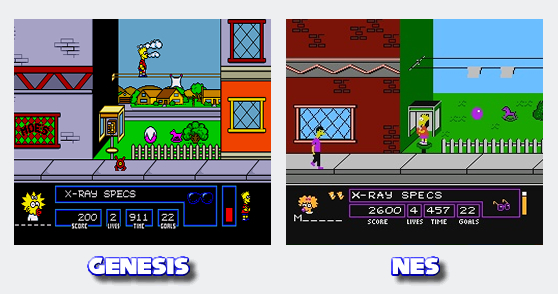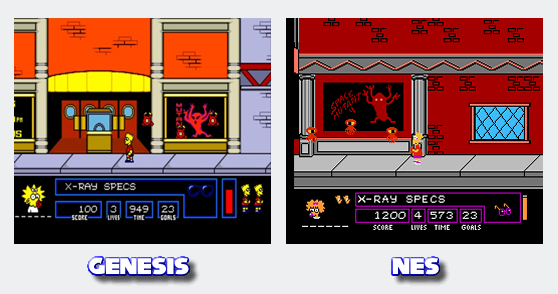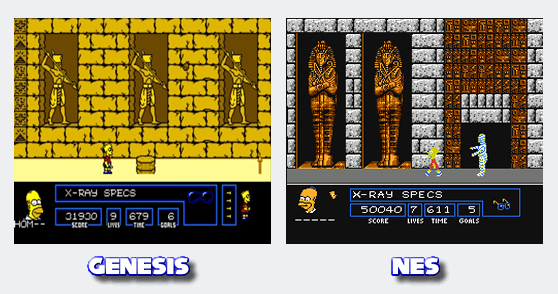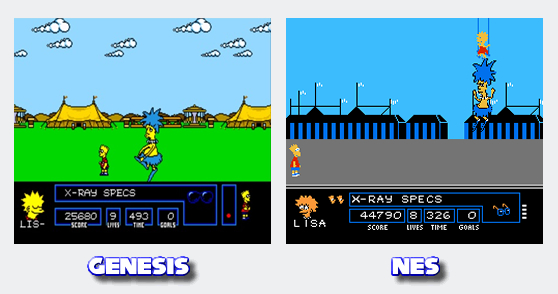Bart vs the Space Mutants is not a game whose legend has aged well, yet in many regards it is a classic platformer, though one of those regards is definitely not inspiration. Make no mistake, this is shovelware, but playable shovelware and even an above average platformer for the NES. Not Mario 3, but not Hudson Hawk either. It’s competently structured, none too short, presents some variety and is fair in its challenge. So here I am to document all the bright and bold improvements those extra 8-bits enabled Acclaim to add for Sega’s versions.
Right out of the gate the question must be answered: “versions?” Yes, plural, because Nintendo evidently still owned some residual licenses during the initial Genesis run that prevented Acclaim from duplicating Simpsons references seen in the NES version. Which brings us to our first category:
The Differences
Presentation: What present day Simpsons fans must bear in mind—and what most usually don’t, contributing to the game’s poor standing on the internet—is how early a product this was within the show’s history. Many later staples had not been fleshed out, characters invented, themes developed. Likewise, many incidental characters (think Bart’s classmates) disappeared or were given facelifts soon afterwards. In a nutshell there were only so many recognizable faces and places to select for a Feb ’91 Simpsons game derived in chief from the ’89-’90 TV season.
The first of these is Moe’s bar, which Bart can prank phone, drawing out an angry…dude. On the NES I’ll be damned if I’m supposed to recognize him; however both Genesis versions clearly depict Moe. Sadly that cameo’s all there is of Moe. But the NES gets its own back with Nelson, the first level boss, looking much more like himself. Indeed, I suspect the SG versions are just copyright-free imitations, as is their Jimbo, who in all three appears on skateboard and, only on the NES, is distinguishable due to the bunny on his shirt. Grandpa’s head pops out of a window equally licensed on all three but is more recognizable on the SG versions. That window belongs to the retirement center, which besides the Kwik-E-Mart, is the only trouble-free landmark in level one. The cinema is generic, though I don’t think the programmers had much to go on yet, this predating the Itchy and Scratchy: The Movie episode. Jebediah’s monument is equally good on all three, but is little more than scenery. Barney’s Bowlarama has apparently been purchased by a faceless corporate chain for the SG release; come Rev A, he’s managed to buy it back.
Unfortunately these pretty much typify the investment Acclaim made in franchising and employing actual Simpsons elements. I suspect they were counting on additional support from Nestlé, as the floating candy bars in level two must have been intended to be Butterfingers. All three versions have nondescript caramel bars.
To wit, the aliens. Why they aren’t Kang and Kodos, the two tentacular green villains who feature in so many Halloween episodes, is probably the same reason why so many obvious elements didn’t make it into this game. (TV cartoons being in the works at least six months in advance of airing should have given Acclaim at least a glimpse of their green forms. Perhaps these video game aliens were Kang & Kodos’s original designs…I leave that for Simpsons diehards to decide). Rather, the diabolical ray gun plan is masterminded by two purple aliens who never show up in the playable parts of the game. Yet something like them is present in the little aliens that litter the opening level’s sidewalks and recur, usually moving in yo-yo fashion, throughout the game. Still purple or reddish, they have a big eye and tentacles and may remind one of Maggie from the Halloween episode where she’s given tentacles. Oh wait, that’s only in the NES version. The SG versions have stark red things that look like little clocks. Great.
Krusty is the last poser. Fittingly, his face seems to have already been licensed out. Sega got it in the amusement park’s big top, but, perhaps owing to the Krusty’s FunHouse game, the face that appears on extra lives is a generic clown’s.
The last licensing element is covered under Music.
Edge: NES
Graphics: Do you love the NES? That is, do you see bright yellow in a well-intentioned tennis-ball? Do you see perfect, subtle realism in monochrome tracts? Do you see all the colours of the rainbow in a screenful of pink? Then the NES version is the one for you. I too love the NES, and this game does look great on it in an NES way, but there’s no denying the Simpsons’ skin looks a touch gangrenous and Bart looks like a squid.
Behold the power of the Genesis!
Or the palette, at any rate. Bart vs the Space Mutants is one of the very brightest games on the Genesis. Bart and his kin are bright yellow, so bright that if one’s just played the NES version before it one may hasten to adjust one’s TV thinking the colour has suddenly gone wrong—exactly as Matt Groening always wanted.
Fundamentally, it’s a success despite some queer alterations like the little aliens mentioned above, the dogs’ change from menacing black to blasé red (along with their sprites), and a general sense that the developers were trying to make it more like any old cartoon rather than the Simpsons in specific. The first skateboarding segment on the SG is unnecessarily tougher because whether those little clock-like aliens are placed front or rear is hard to discern.
The Simpsons themselves are greatly improved, half due to the more visible colour, half due to editing or simply those eight extra bits. Maggie, whose name Bart must spell if he wants some aid against Nelson, no longer resembles an aged banana peel. Likewise, the rest of the family’s portraits are clearer. The townsfolk, along with the aliens inside them, are changed slightly for the worse; details are added that make them feel too busy. The NES X-ray effect is stark black; the Genesis is black and green.
Environments are the biggest change. Gone is the soothing grey monochrome tract of a mall that was level two. It’s been replaced with colours from Burgertime. Not only that, everything is, again, busier: the stomping shoes are unnecessarily patterned, the shop windows bear silly names, the hats are more varied yet less appealing. The whole game is like that; there’s no room to list every change. Since RevA reinstates the few Simpsonian traits the NES had to keep it afloat amidst the game’s sea of randomness, it’s the clear Genesis choice. However the SG versions lay the colour on very thick whilst the show was not so heavily pigmented in its pre-digital age.
Edge: Draw (NES & Genesis Rev. A)
Sound/Music: The NES game is infamous for inflicting the Simpsons theme song, a lone new tune arranged from that, and a boss riff, nothing more, upon its players throughout what can add up to an achingly-long play session. Naturally, the Genesis versions improve upon this by… removing the theme song and boss riff??? Licensing again, but come on. And no, this is not the sort of music that gains by greater clarity.
The NES game is also infamous for recycling a bunch of shooter noises for the sounds that accompany Bart along his path all the way through the ultimate nuclear plant, whilst he has nothing to say but “eat my shorts, man.” Top off those with an irksome “thunk” noise when hit. Surely Acclaim and Flying Edge would see fit to boost their houses’ profits and reputations by….*(insert Marge’s famuos hmmhnm).* Somehow I really expected to hear Moe’s voice when he picks up the phone; a couple lines each for him and Bart, how hard would that be? It’s not as if they were using the cart space for much else.
Pausing the Genesis games, which is frequent because that’s how the inventory is accessed, pauses the music too, making for a pronounced interruption. If the Genesis versions add anything, it’s tiny incidental sounds the repeated song will have made you deaf to.
Edge: NES
Gameplay: You will read elsewhere online that Bart vs the Space Mutants on NES is as tough as Ninja Gaiden, Ghosts ‘n Goblins, or even Battletoads. Rubbish. The difficulty is absolutely average. The controls, also maligned, are perfectly functional. Bart’s power jump is a bit jerky, and he slides on landing it, in both cases similar to Mario in SMB1. What contributes to some players’ frustration with it is that there’s no grace period holding down the direction one’s jumping in and landing the jump, so that when Bart “sproings” across a good third of the screen towards a tiny platform balanced between two instant deaths the player must let off the d-pad just before he lands, otherwise the continued pressure will cause Bart to take another step right off the platform. This appears to be slippery controls until one discovers how to handle them. The set up varies from good to perfect depending on how well placed your controller’s select and start are for you. There’s also a wealth of 1ups; the counter maxes at nine but the excess are recorded. A couple of irritating checkpoints prolong level four’s tar pits, but they’re it for cheapness.
On neither system can the controls be arranged. This is what screws our Genny. Because Bart’s power jump is executed by “simultaneously” pressing A+B, ie, as all NES two-button moves, A is pressed slightly before B, meaning a simple press of the thumb from the controller’s edge inwards. The Genesis controller reverses this, an awkward motion. Pressing A+B exactly at once will result in a normal jump and spray/slingshot. ** Yet it is possible players who begin on the Genesis will not be so bothered as I was after coming to it from the NES. The SG sprites also move slightly faster, which is not an advantage since the game is largely static platforming, and generally one will not want Bart zipping about.
The SG games conceal far fewer 1UPs; at best they may be moved, but I suspect they’re just gone. On the NES there might be three dozen; the SG, perhaps 20. Essentially enough of a reduction to require a thorough practice round before sitting down to beat it.
It’s harder in other aspects too. The bosses, weak on NES, now pose a challenge with increased firepower: Nelson throws water balloons quickly, the mall mid-boss (Skinner on NES, which is so random his appearance counts for nothing) now shoots, and so on to the point that at the least most players will need a walkthrough to pass level four since it’s now much too hard for experimentation.
The remainder of the gameplay is unaltered. –Bart sprays flowerpots standing rather than jumping, but so what? There are no additions of any kind to the Genesis versions. The removal of so many 1ups (along with presumably the in-game sound test: the Kwik-E-Mart secret is gone) cramps casual replay value, whilst the added boss difficulty diminishes the feasibility of a no-death run. Moreover, a fourth generation game of cartoon nature ought to include variable difficulties.
One last note is that the jump button is held after jumping to enable Bart’s run. This is sometimes a cause of complaint on the NES version, and so logically it would be more annoying the Genesis didn’t give run its own button, except that it’s not a problem. Bart literally never once needs to run, every bobbing alien and obstacle can be passed at walking speed. It’s just a bonus afterthought, and due to enemy placement throughout the game, having to jump (in place) before running is not a liability. Bart jumps his maximum distance without a run-up.
Edge: NES
Final Assessment
NES owners and Simpsons fans should go for the NES game. Simpsons fans who don’t care about playing should get either Genesis version, as it’s easier to come by CIB. Genesis stalwarts and Simpson fans should get Revision A. Genesis stalwarts who don’t care about the Simpsons will be equally well served by either cart. It’s worth playing on NES because it’s an above average platformer without the high difficulty of so many classics. It’s worth playing on Genesis because every game with a bad reputation should be judged by oneself.





Recent Comments